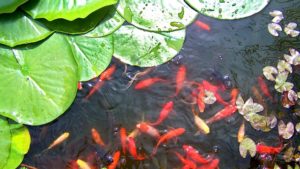A well maintained pond is a healthy one that will be the focal point in any garden. The key is to keep the water clear and ensure that plants do not take over. A pond with an established balance between plant and animal life requires less attention than one where there isn’t this harmony and there is a resultant surge in algae growth. Here are a few tips to help guide you through maintaining your pond through the seasons:
Winter care
- Continue to remove dried leaves and any other debris from water surface
- Dead head plants (remove dead or spent flowers before it sets seed) to encourage new growth and allow for bigger and brighter blooms of flowers. By removing spent flowers, the plant will have energy to continue to make new flowers instead of producing seeds. If a plant is left to set seed, its life cycle is complete and it
- Remove dead leaves from pond plants and move hardy plants such as lilies towards the deepest part of the pond to prevent their tubers being frozen.
- Fish slow down as the temperatures drop. Start feeding them easy to digest foods at the start of winter. When temperature drops below 100C (50F) stop feeding them, as they don’t digest food. Plants that would normally remove waste are also in a dormant state so increased level of fish faeces would affect the water quality due to ammonia and nitrates leaving them to build-up. Koi don’t have stomachs so what they eat and their bodies don’t need will only be excreted. What they eat is for the purpose of growth, colour and energy. Koi are cold-blooded so metabolism is dependent on water temperature.
- Keep pond from freezing over for any length of time. If you leave it to remain frozen over gases will build-up, oxygen levels will drop and affect survival rate of your fish.
Spring pond maintenance
- The water starts to get warmer bringing your garden water feature back to life. This is the best time for general maintenance on your pond and pond liner to prepare for a healthy, flourishing summer for your fish and plants
- If you removed your pump and filter during the winter months, now is the time to re-install them back into your pond
- Pumps and filters that have been running through the winter need a thorough clean

- A great time to start the cleaning process by netting-out any debris that has fallen to the bottom of your pond including shelving surfaces. If left it will cause a rise in nutrient levels, which can lead to algae growth. Use a pond vac or skimmer net to remove debris. This is a job that need not be done to absolute perfection as a complete cleaning will upset the natural balance and algae control
- Test the health of the water. It should be around a pH of 7.0 to 7.8. Start doing a 10% water change to keep pond healthy
- Reinstall pond pump, filter and aerator, as they are needed most during warmer weather. If you didn’t run your pond pump through winter, make sure your pump is clean and in good working order before stating it up again
- Check filter for leaks and proper flow rate
- As the water warms fish start to swim to the surface looking for food. At temperatures between 5°C and 10°C fish can be fed low protein foods, such as wheatgerm. Above 10°C they can be fed general fish pellets.
- Add new plants if appropriate or repot and fertilise existing plants before returning to pond
Summer
- Keep algae under control. Rake away long filamentous algae from the water surface.
- Check and clean the filter regularly
- Warm water encourages the growth and presence of parasites on fish
- Feed fish regularly with a high protein food to encourage growth. Warm water temperatures stimulate metabolism so little of the food eaten will be excreted. Koi fish are omnivorous eating both plant and animal matter such as algae, aquatic plants, worms, larvae and crustaceans – therefore can supplement their diet with what is available in the pond if required
- Top-up water levels regularly during hot, dry periods. This will avoid undue weathering of exposed pond liner (although rubber pond liners are UV and temperature resistant so are not likely to go brittle and crack or damage if exposed to the sun). A significant drop in the water level would, however affect the amount of oxygen available for fish. Ideally, fill-up with rainwater from a butt rather than tap water, which is full of nutrients and will cause algae growth
Autumn
- Use a net to sweep leaves from surface of pond to keep the water free of decaying vegetation
- Remove dead leaves to avoid decomposing vegetation build-up. Prune back excess growth of submerged plants so that plenty of light penetrates your pond to allow plants to continue to photosynthesise and replenish oxygen levels






